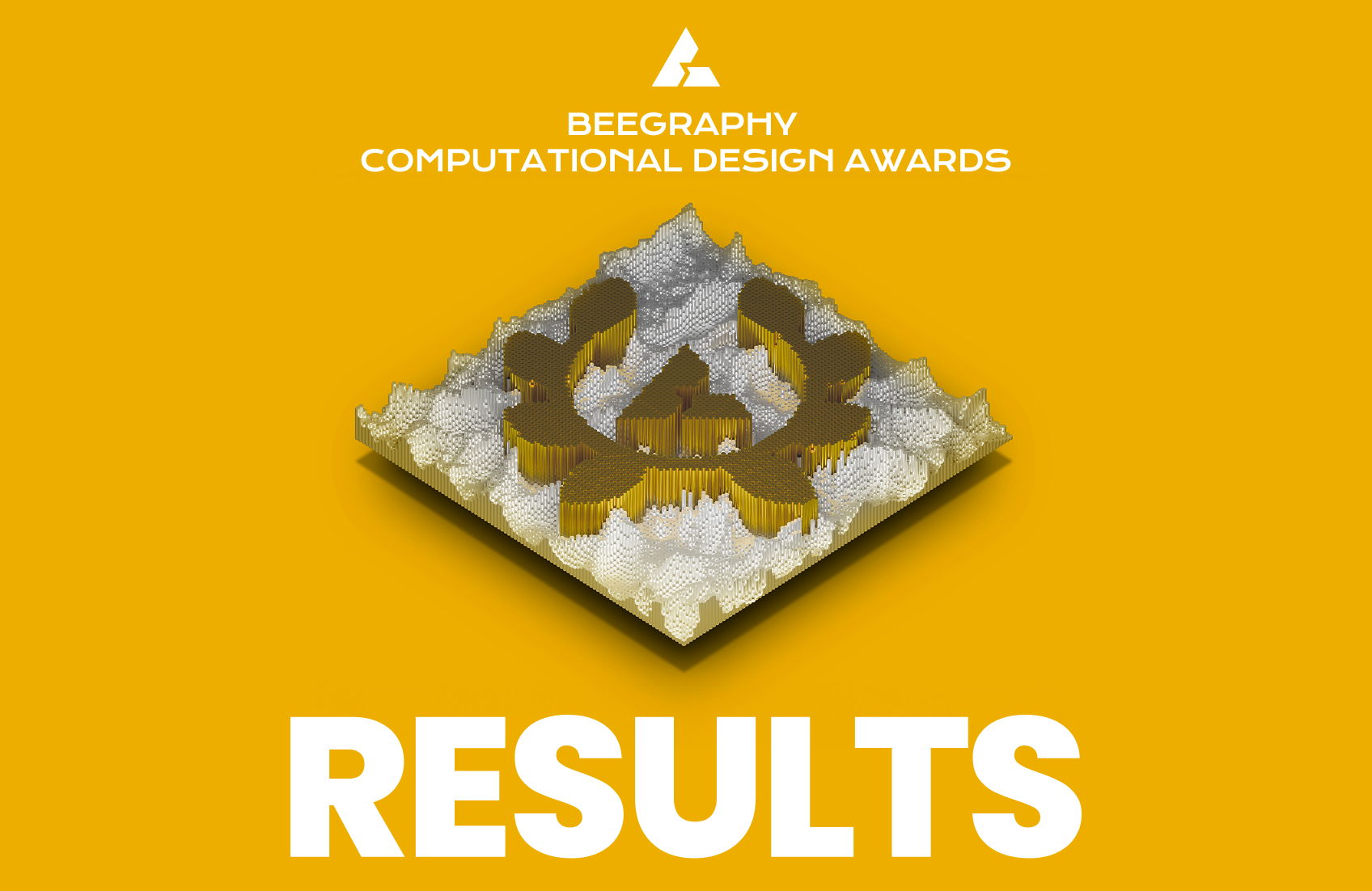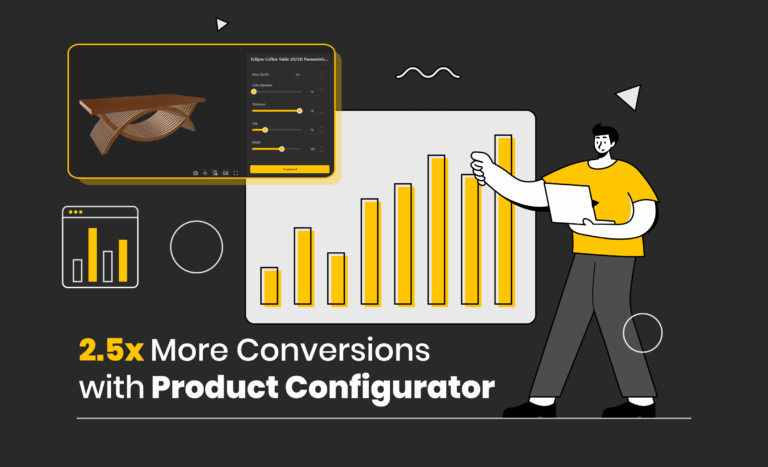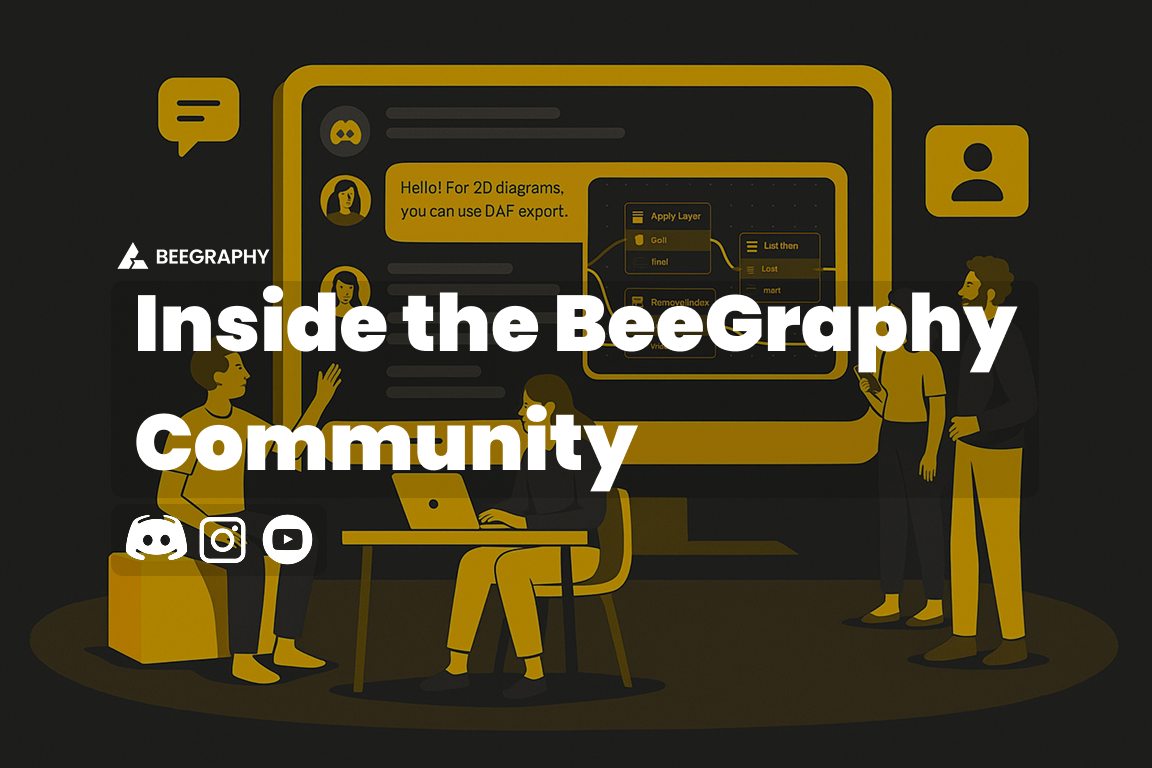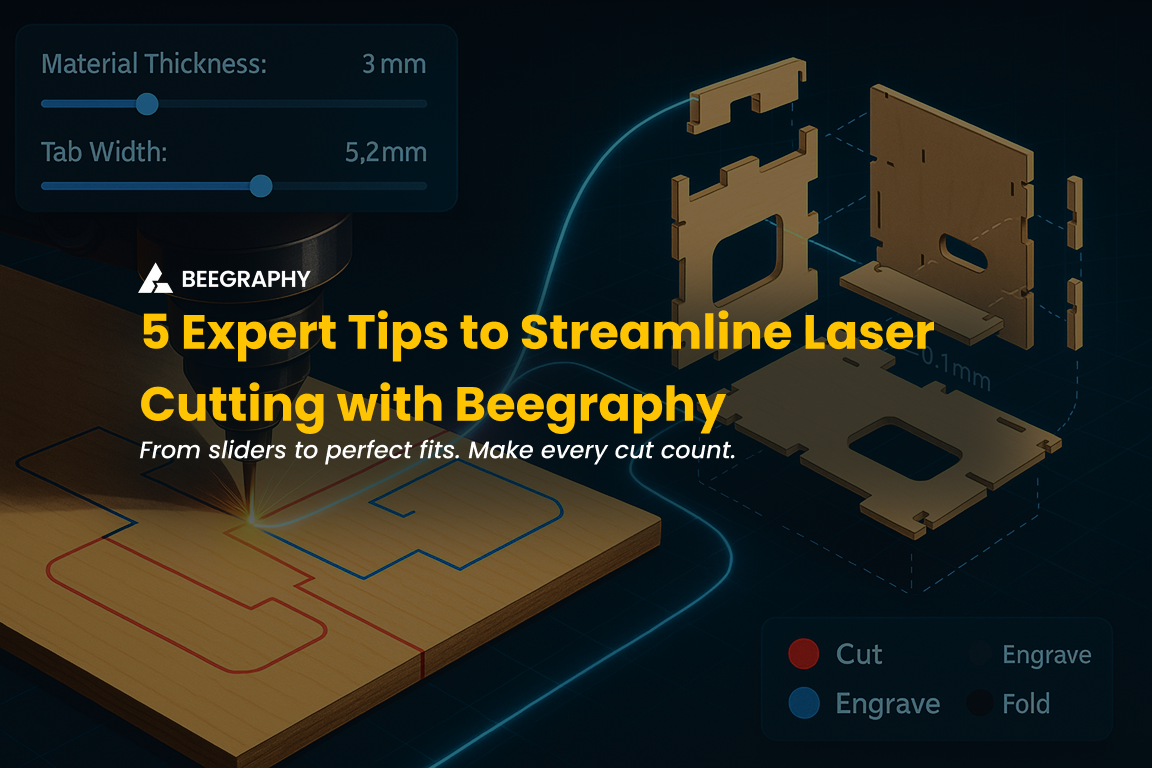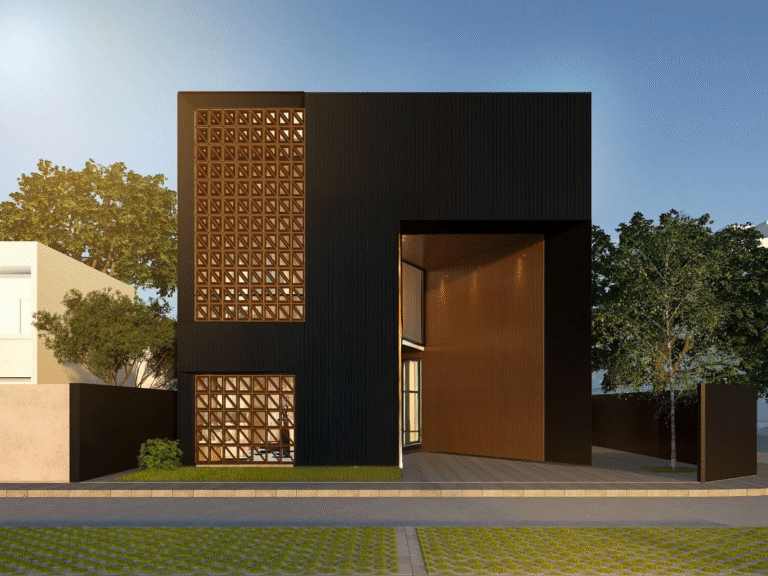Table of Contents
At its core, design is a way of thinking. A blend of structure and creativity, logic and imagination. And parametric design takes that one step further. It lets us turn thought processes into form, and ideas into adaptable, intelligent systems. But for too long, this way of designing has remained locked behind complex tools and steep learning curves.
We believe it doesn’t have to be that way.
BeeGraphy was created with a single, evolving goal: to make parametric modeling accessible. Accessible in the truest sense , where anyone with a browser and an idea can begin creating, no installations or expensive licenses required. From classrooms to studios, BeeGraphy envisions to open the door to a new way of working: visual, collaborative, and fabrication-ready.
To bring that idea to life, we introduced the BeeGraphy Computational Design Awards, our very first global challenge. It wasn’t just a chance to test the platform. It was also a way to connect with the community, to learn from real-world creators, and to understand what inspires and challenges them. We saw entries from over 35 countries, and while professionals joined too, it was especially exciting to see strong participation from students. Their ideas, bold and experimental, set the tone for everything this award hopes to stand for.
And BeeGraphy Computational Design Awards was a celebration of design, it was also a moment of listening for us as a young and evolving platform. The feedback, the experiments, the enthusiasm. They’re helping shape the future of BeeGraphy.
Global Participation and Community Impact
We were genuinely amazed by the scale of participation from within the computational design community. Over 1000 creatives registered which included designers, students, educators, and engineers, bringing nearly 200 submissions to life. It wasn’t just about BeeGraphy. It was a celebration of a shared mindset and a sense of community for all the Computational designers . A global network that believes in the power of parametric thinking, creative logic, and open collaboration. This Awards edition proved one thing above all that the community is thriving, and it’s just getting started. We are about to witness a strong sense of community in the upcoming future.
What made this truly special wasn’t just the numbers. it was the people. From architecture and fashion to education, engineering, and product design, participants brought their unique lens to computational thinking. Some were students diving into their very first parametric challenge. Others were seasoned professionals exploring new ways to bring client-ready ideas to life.
But no matter their background or experience level, everyone stood on equal footing. That’s the beauty of a community-driven platform. With BeeGraphy’s browser-based editor, there’s no need for complex software setups or installations— creativity takes the lead. Whether designing, publishing, or receiving feedback, everything happens in one seamless, real-time ecosystem. The smooth, uninterrupted workflow allows a designer’s creative space to truly flow freely.
This isn’t about a competition or a platform but It was a reminder that when accessible tools meet a passionate community, innovation isn’t just possible—it’s inevitable.
Categories of Design Innovation
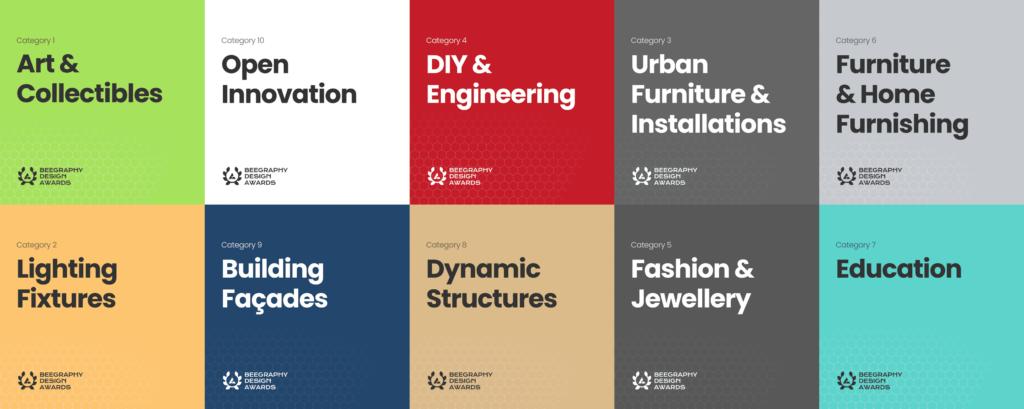
The 10 official categories of the BeeGraphy Computational Design Awards, covering a wide spectrum of computational design applications.
To spark creativity across disciplines, the competition offered 10 thoughtfully crafted categories—each reflecting a real-world design opportunity, and each encouraging participants to think beyond the conventional designs and not just about the aesthetics but also
- Art & Collectibles
Where form meets emotion—this category invited creators to craft sculptural objects with artistic expression and algorithmic precision. - Lighting Fixtures
A space to play with illumination and ambiance, encouraging designs that transform how we experience light, shadows, and space. - Urban Furniture & Installations
Designs that reimagine how we interact with public spaces—functional, inviting, and deeply rooted in the urban fabric. - DIY & Engineering
For the tinkerers, the thinkers, and the builders—entries here brought logic and function together through parametric DIY tools and smart components. - Fashion & Jewelry
An exploration of wearability and beauty, this category merged digital craftsmanship with personal expression through form, texture, and material logic. - Furniture & Home Furnishing
From tables to storage systems, this was a call to redefine domestic comfort using flexible, fabrication-ready workflows. - Education
Designs with a purpose—to teach, to engage, to inspire. Whether playful or practical, these tools were built to foster learning through interaction. - Dynamic Structures
Entries here focused on motion, responsiveness, and transformation—where geometry wasn’t static but alive and evolving. - Building Facades
For those who see buildings as canvases—this category looked at performative skins and architectural surfaces shaped by data and design. - Open Innovation
A space for rule-breakers and boundary-pushers—entries that didn’t fit into boxes but carved out new paths for computational creativity.
Each category was more than a brief—it was a prompt for discovery, experimentation, and real-world relevance.
📎 Explore the full competition brief here.
Competition Format and Timeline
The BeeGraphy Computational Design Awards unfolded in two carefully structured stages designed to highlight both creativity and technical finesse.
Stage 1 – Open Submissions & Initial Shortlisting
Participants submitted parametric models across ten categories via the BeeGraphy Marketplace. Each entry featured a published 3D model, a short design statement, and a list of adjustable parameters. While community voting was initially considered, the final shortlisting was carried out internally to ensure fairness. The jury and organizing team evaluated all submissions, advancing the top 70 entries based on design quality, clarity of logic, and completeness—excluding only those that were too raw to qualify.
Stage 2 – Design Refinement & Final Submission
Shortlisted participants refined their work with a focus on fabrication readiness and narrative depth. Final submissions included high-quality visuals, exportable CAD files, parametric diagrams, and embedded model views—ready for expert evaluation by the jury members.
Workshops and Learning Opportunities
To prepare participants for success, BeeGraphy hosted four in-depth workshops from July to October 2024. These hands-on sessions welcomed everyone—from first-timers to experienced professionals—into the world of algorithmic thinking.
Workshop Series:
- Foundations of Parametric Design
- Lighting and Urban Design
- Fashion and Home Design
- Dynamic and Architectural Design
Each of these workshops felt less like a tutorial and more like a conversation with the community. Led by experienced educators, they walked participants through everything from the basics of node-based design to preparing files for real-world fabrication and it all became easier using the BeeGraphy Editor. Whether you’re brand new to computational design or just looking to sharpen your skills, there is something for everyone.
And the best part? You can still catch all the sessions on YouTube, anytime you want. So if you’re just getting started or want to explore more, you’re already in the right place. You’re just a click away from becoming part of the community.
👉 Join our Discord to connect with fellow designers and the BeeGraphy team. We’re super active and always happy to help—whether you have questions, need feedback, or just want to chat about an idea.
BeeGraphy Computational Design Awards Jury Panel
We invited computational designers and industry experts from across the globe to share their feedback and help review the incredible work submitted by our Community Members. Our jury panel of 25 designers brought together a wealth of experience—spanning continents, disciplines, and decades of experimentation in computational design. What made this panel so special was its diversity; every submission was viewed through a rich lens of architectural innovation, academic insight, digital fabrication, and creative storytelling. Their collective perspectives helped ensure that each entry was appreciated not just for how it looked but for the logic, craft, and potential it carried.

Meet the jury panel of the BeeGraphy Computational Design Awards
The jury included a few of our esteemed panelists, such as:
- Julia Koerner
Founder, JK3D | Adjunct Professor, UCLA
Renowned for her 3D-printed couture and contributions to Marvel’s Black Panther.
- Mohammed Mansoor
Lead Designer, Rafael Viñoly Architects
Formerly at SANAA and RAMSA; expert in computational pavilions and sustainable urban interventions.
- Christopher Bullen
Instructor, Mount Royal University
Educator and parametric design specialist with a focus on visualization and fabrication workflows.
- Tim Fu
Founder, Studio Tim Fu | Formerly with Zaha Hadid Architects
Pioneer in AI-integrated computational workflows and generative aesthetics.
- Laurent Lescop
Professor, ENSA Nantes
Researcher in immersive media, digital reconstruction, and architectural pedagogy.
- James Solly
Director, Format Engineers | Tutor at AA Design + Make and Bartlett
Structural design expert with deep insight into engineering-based parametric logic.
- Eliana Nigro
Head of Computational Design, COBE | Founder, ELNI Studio
Leads modular and user-focused design initiatives, with a passion for accessibility in digital workflows.
- Gediminas Kirdeikis
Co-founder, VGAC | Course Coordinator at Lund University
Academic, designer, and computational educator, well-known for public-facing design tutorials.
- Erwin Redl
Media Artist
Internationally exhibited artist, using algorithmic installations to explore space, light, and interaction.
10. Grigor Grigoryan
Computational designer and architect, focused on geometry-driven workflows and digital fabrication for architecture and art.
BeeGraphy Computational Design Awards Results and Highlights
Shortlisted Finalists
The 65 shortlisted entries represented a broad spectrum of innovation—from modular shading systems to fabrication-ready jewelry prototypes. The sheer diversity was a testament to how flexible and powerful parametric workflows can be when guided by strong ideas.
Award Winners
Winning Entries: A Showcase of Computational Brilliance
The BeeGraphy Computational Design Awards united a global cohort of creators, all leveraging computational logic to turn ideas into compelling, buildable realities. The winning designs are more than aesthetic achievements—they are technical statements made through the language of parametric modeling.
Each of these entries exemplifies what happens when logic-driven design meets creativity, enabled entirely by the BeeGraphy platform’s robust modeling and fabrication-ready environment.
Grand Winners
Winner (Professional)
Project: Table Orbs
Designer: Michael Sterling
Category: Furniture & Home Furnishing
A masterful blend of symmetry, form, and fabrication logic, Table Orbs impressed the jury with its structural elegance and manufacturing clarity. With every component parametrically driven, this design reflects the full potential of BeeGraphy’s drag-and-drop node environment.

Table Orbs by Michael Sterling – A symmetrical, fabrication-ready furniture piece showcasing structural elegance. View project
Winner (Student)
Project: Petals Lampshade
Designer: Eda Özaltay
Category: Lighting Fixtures
Petals Lampshade mimics the blooming patterns of nature using controlled repetition and light modulation. Designed entirely on BeeGraphy, it balances poetic form with digital precision—an inspiring entry by an emerging talent.
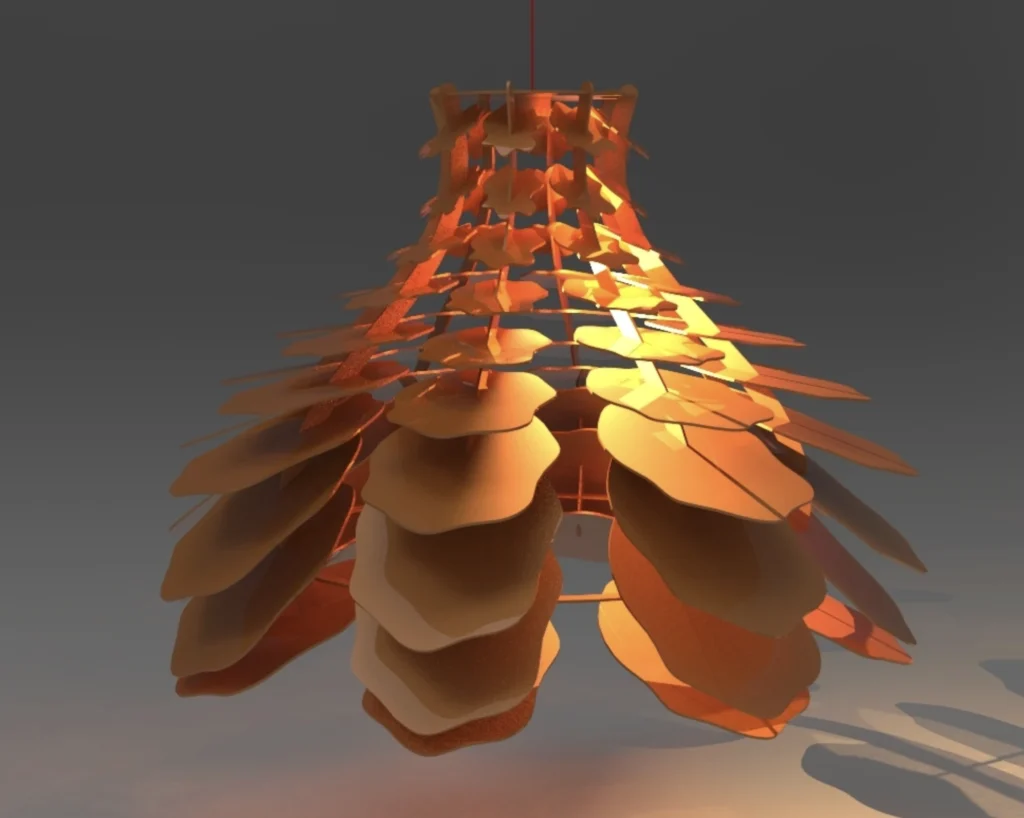
Petals Lampshade by Eda Özaltay – A floral-inspired lighting design balancing poetic form with parametric precision. View project
Runners-Up
LuxOre by Kseniia Bondarets and Belgi Ozdemir
A stunning example of lighting geometry, LuxOre utilizes radial symmetry and texture variation, presenting a professional-grade concept built on BeeGraphy’s parametric workflow.

LuxOre by Kseniia Bondarets – A kinetic lighting fixture exploring symmetry and surface variation. View project
PIN ART Wall by Laurita
An interactive, tactile surface concept that transforms based on user input. Its Open Innovation strength lies in adaptability and user engagement—completely defined using BeeGraphy’s logic blocks.

PIN ART Wall by Laurita – An interactive, tactile surface that responds to user input through parametric logic. View project
ArcNest Pet Bed by dean pickford
A design that merges pet comfort with spatial design, the ArcNest showcases how even everyday products can benefit from computational modeling.

ArcNest Pet Bed by deanpickford – A cozy, parametric pet bed merging form, function, and comfort. View project
Category Winners
Art & Collectibles
This category saw two equally strong entries that will share the winner title. Fallen Leaves by Amir Ahmed presented a poetic, seasonal form built through layered geometry, while Polyhedra Sculpture by Lars Renklint impressed with its structured logic and educational value.

Fallen Leaves by Amir Ahmed – A meditative, seasonal sculpture formed through layered parametric geometry. View project

Polyhedra Sculpture by Lars Renklint – A geometric study of polyhedral forms for educational and gallery use. View project
Lighting Fixtures
Lumos Kinetica by Bartu Lokumcu introduced a kinetic light fixture responsive to spatial intent, using modular logic to explore ambient control in a fresh, dynamic way.

Lumos Kinetica by Bartu Lokumcu – A kinetic lighting design driven by modular parametric logic. View project
DIY & Engineering
Silicone Baking Tin by Lars Renklint proved that everyday objects can be reimagined through parametric thinking, blending utility with ease of home manufacturing.

Silicone Baking Tin by Lars Renklint – A functional DIY design made using parametric tools. View project
Fashion & Jewelry
Ring by Robert Rodriguez showcased wearable architecture with mathematical elegance, blending geometry and fashion into a minimal yet expressive form.

Ring by Robert Rodriguez – A mathematically inspired jewelry piece reflecting wearable parametric design. View project
Furniture & Home Furnishing
Hummingbird Table by Emanuel Rezende Bhering brought sculptural motion to life—an expressive, fabrication-ready design that balances beauty and practicality.

Hummingbird Table by Emanuel Rezende Bhering – A sculptural, fabrication-ready table design inspired by motion. View project
Education
Abacus by Viviana Andrea offered an interactive learning tool, where every parameter served a pedagogical purpose—merging design with functionality.

Abacus by Viviana Andrea – A hardwood learning tool that blends educational function with parametric form. View project
Dynamic Structures
Nautilus by Kseniia Bondarets and Belgi Ozdemir took inspiration from Fibonacci logic, resulting in a spiral table form that challenged balance and structure.

Nautilus by Kseniia Bondarets – A transformative coffee table inspired by Fibonacci geometry. View project
Building Facades
Restaurant / GreenHouse by Amir Ahmed combined sustainability and smart patterning, rethinking solar optimization through a parametric lens.

Restaurant / GreenHouse by Amir Ahmed – A sustainable facade concept blending a diamond pattern with greenhouse glazing. View project
Urban Furniture & Installations
Bamboo Tree Pavilion by Pranav Raghavan celebrated organic flow and modular construction, standing out for its fabrication clarity and immersive spatial quality.

Bamboo Tree Pavilion by Pranav Raghavan – A modular parametric structure capturing natural flow in an urban setting. View project
Open Innovation
We received a single submission in this category—PIN ART Wall by Laurita—which earned a Runner-Up recognition for its interactive surface logic. No separate category award was given.
Explore how the BeeGraphy Design Awards is shaping the conversation on computational design.
These winning entries reflect the true versatility of parametric design and the kind of creative freedom BeeGraphy aims to support. Whether it was a sculptural installation or a functional household object, every project was –
• Built entirely in the BeeGraphy Editor
• Defined through dynamic, fabrication-ready parameters
• Published on the BeeGraphy Marketplace for global access
Together, they highlight a growing shift in the design world. Where accessibility, collaboration, and code-free computation are becoming the new standard. BeeGraphy is proud to be a part of that evolution. We are young but we are ready to lead the new – age evolution.
Jury Reflections: Inside the Minds Behind the Judging Panel
The BeeGraphy Computational Design Awards welcomed a panel of globally acclaimed jurors – architects, educators, engineers, and computational design pioneers. With over 65 shortlisted entries across 10 categories, our panel had the thrilling and challenging task of evaluating submissions not only for design quality but also for parametric logic, feasibility, and innovation.
We reached out to many of our jurors through live sessions, calls, and asynchronous reviews to better understand their impressions. Here’s a curated dive into their perspectives.
What was the overall jury experience like?
“This was the first time I judged a competition where I could manipulate the geometry. It wasn’t just looking at PDFs or renders—I was testing parametric controls. That made this uniquely powerful. It bridges the gap between designer and consumer, especially when applied to product customization.”
– Julia Koerner
“I was amazed at the sophistication of computational methods used—some entries, like the Bamboo Tree Pavilion, were entirely script-based. It was fascinating to see students and professionals alike pushing the boundaries of cloud-based parametric scripting.”
– Mohammed Mansoor
“The evaluation was smooth. I especially enjoyed seeing students learn to balance aesthetics with fabrication-ready outputs. The nesting features and script-based logic added a whole new layer to design exploration.”
– Christopher Bullen
What kinds of entries stood out?
Our jurors praised the diversity of submissions—from poetic lighting pieces and algorithmic fashion accessories to highly engineered structures and whimsical pet furniture.
Orb Table: “A complete, functional, and refined design—ready for fabrication.”
Mushroom Chair: “Impressive use of parameters that completely transform the design.”
Wobbly Table: “Unconventional geometry done right. A great example of freeform design logic.”
– Tim Fu
Elegant Waveform Bracelet: “It came with a physical prototype—so rare. It showed the full journey from parametric logic to tangible object.”
– Julia Koerner
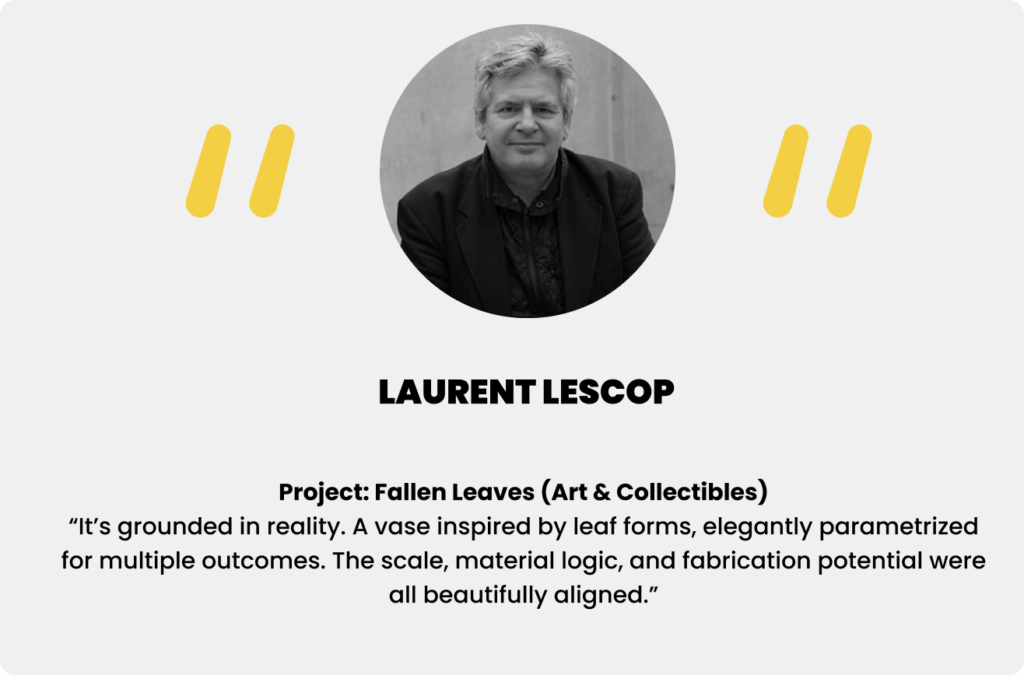
Laurent Lescop on Fallen Leaves – “A poetic yet grounded parametric design, with material logic and fabrication beautifully aligned.”
How did the judging process work?
The evaluation was designed around transparency, ease, and fairness. Each juror was assigned a specific category and scored entries using a weighted metric system on criteria like aesthetics, technical depth, usability, and fabrication readiness.
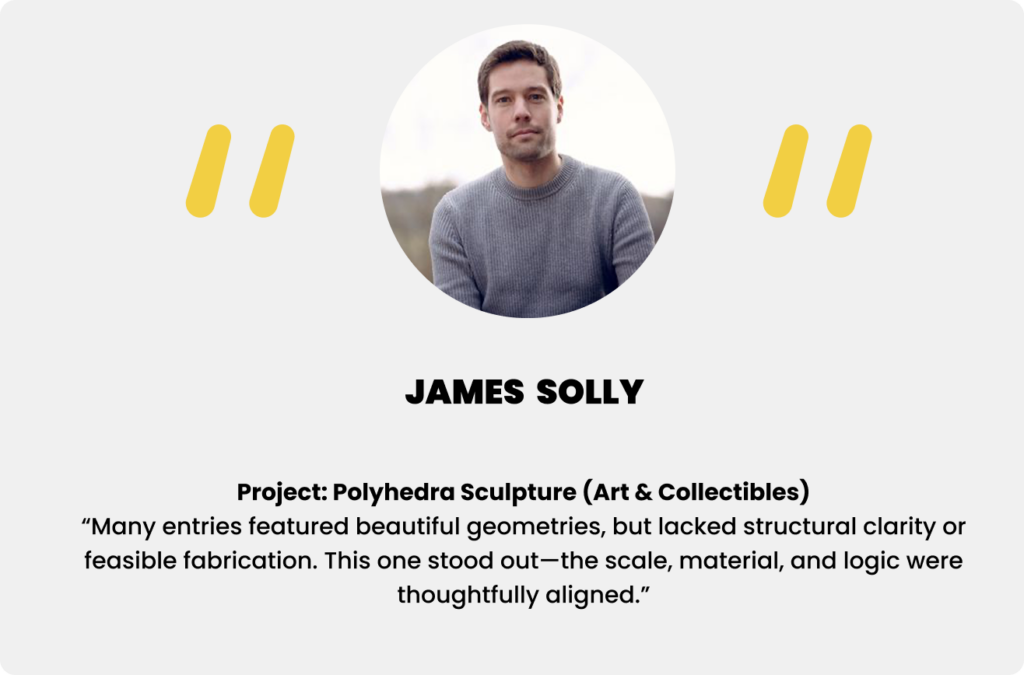
James Solly on Polyhedra Sculpture – “A standout among visually complex entries, praised for its clarity in structure, material, and build logic.”
What technical or conceptual issues were observed?
While the creativity on display was truly exciting, several jurors pointed out areas where many entries could grow further:
- Parameter Control: Some models offered too much flexibility, which led to broken or unstable geometry. Jurors like Laurent Lescop and James Solly emphasized the importance of well-curated parameters to ensure meaningful outcomes every time a design is adjusted.
- Materiality and Scale: A recurring gap was the lack of information about materials or real-world dimensions. Without this, even the most visually stunning designs can fall short when it comes to actual production.
What’s the future potential of BeeGraphy as a design tool?
For many of the jurors, the competition was also a window into the evolving possibilities of browser-based computational design.
“A cloud-based parametric scripting tool with real-time collaboration and a marketplace? That’s a promising direction. It opens doors for more people to experiment with advanced design logic.”
— Mohammed Mansoor
“The idea that students—or even casual users—can shape parametric models directly in the browser is powerful. It’s not something many tools currently offer.”
— Julia Koerner
“What stood out to me was how the platform helped translate ideas into fabrication-ready forms. For students, it invites exploration. For professionals, it’s a workflow enabler.”
— Laurent Lescop
As a first edition, the competition offered a meaningful glimpse into how accessible tools can foster creativity, experimentation, and practical outcomes—all within a shared digital space.
Which designs received specific praise?
A few entries sparked thoughtful appreciation across the jury for their creativity, feasibility, and execution:
“Fallen Leaves (Art & Collectibles): Highlighted by Laurent Lescop and James Solly for its elegant geometry and adaptable scale—an evocative design grounded in both poetry and practicality.”
Bamboo Tree Pavilion (Urban Furniture): Recognized by Mohammed Mansoor and Erwin Redl for its ambitious scripting and sustainable design strategy.
Petals Lampshade (Lighting): Commended by Chris Bullen for its versatile form and thoughtful lighting effects, though he suggested refining nesting for cleaner fabrication.
Lumos Kinetica (Lighting): Gediminas Kirdeikis appreciated the functional prototype and considered it a strong example of design ready for real-world application.
PIN ART Wall (Open Innovation): Lauded by Laurent Lescop, James Solly, and Chris Bullen for its simplicity and hands-on potential—making parametric logic tangible and interactive.
Elegant Waveform Bracelet (Fashion): A personal favorite of Julia Koerner, who appreciated the balance of refined aesthetics with a clear pathway to 3D-printed realization.

Note: To read the jurors’ feedback, please visit project entries on UNI
Any final thoughts?
This first edition of the BeeGraphy Design Awards felt less like a competition and more like a shared conversation. Across countries, time zones, and disciplines, people came together to try something new—to explore parametric design in a space that encouraged learning, experimentation, and creativity.
What stayed with us wasn’t just the range of projects, but the thoughtfulness behind them. Whether it was a poetic vase, a kinetic lamp, or a playful piece of urban furniture, every entry carried a bit of its creator’s curiosity and intent.
Our jurors didn’t just evaluate—they interacted, gave feedback, and celebrated the effort behind each idea. As Laurent Lescop summed it up: “It’s more than software. It’s an exploration platform.”
We’re putting together a short video capturing some of those jury reflections. You’ll be able to find it soon on our Instagram and LinkedIn pages.
A Note from BeeGraphy’s CEO, Grigor Grigoryan
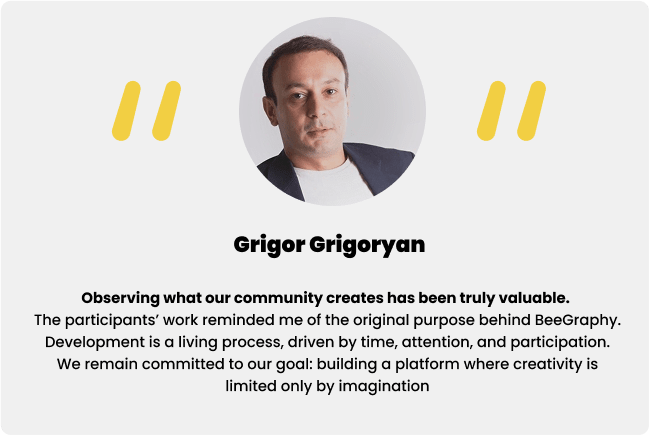
In addition to this message, Grigor shared his thoughts on community engagement and the development journey:
“Community feedback was especially important to us. We made every effort to respond promptly to user requests. Naturally, not all ideas could be implemented at this stage, and for that I sincerely apologize, particularly to those who were unintentionally affected by the updates.
“Thank you to everyone who took part in this phase. Your engagement and ideas are a key driver of BeeGraphy’s continued development.”
The BeeGraphy Platform Advantage
What truly powered this global surge of creativity? The answer lies in the platform that brought all these brilliant ideas to life—BeeGraphy.
More than just a modeling tool, BeeGraphy is a complete computational design ecosystem. Built for designers, educators, and innovators across disciplines, the platform offers a seamless blend of technical depth and user accessibility, making it easy for both beginners and advanced users to bring their parametric visions to life.
Here’s what makes BeeGraphy a meaningful part of the computational design workflow:
- Visual Scripting Interface
Design with logic—without writing code. The intuitive drag-and-drop editor makes algorithmic modeling feel more like sketching than programming. - Live Collaboration
Build together in real time. Whether you’re co-designing, teaching, or mentoring, BeeGraphy lets you collaborate seamlessly, right in your browser. - Fabrication-Ready Output
Export instantly in STL, DXF, OBJ, and other formats—so your design can move straight from screen to production, without any extra steps. - Cross-Device Cloud Access
Your projects live in the cloud, so you can design anywhere—on a laptop, tablet, or desktop—without any installations or hardware limitations. - Marketplace Integration
Share your work with the world, publish parametric models, and explore reusable design components through BeeGraphy’s growing online marketplace. - Built-In Product Configurator
Easily turn your models into ready-to-use configurators that anyone can interact with—perfect for educators, teams, and businesses looking to offer customizable products without the need for custom coding.
Throughout the competition, BeeGraphy served as a collaborative space where ideas took shape, evolved, and grew. Its environment supported learning, experimentation, and real-time design.
Educators, fabrication labs, and studios have started using it in their workflows—for teaching, prototyping, and exploring the possibilities of parametric design.
Experience the platform that’s shaping the future of design.
Stay Connected with BeeGraphy:
- Workspace: Start creating
- Trainings: Learn at your own pace
- Marketplace: Explore and share designs
- LinkedIn: Follow BeeGraphy on LinkedIn
- Instagram: Check out BeeGraphy on Instagram
What’s Next?
The BeeGraphy Computational Design Awards brought together a diverse and vibrant community spanning continents, disciplines, and design philosophies, all speaking the shared language of computational design. It was never just about winning; it was about exchanging ideas, exploring new methods, and celebrating the creativity that emerges when tools are made accessible to all.
What truly stood out wasn’t just the sophistication of submissions, but the people behind them—the students, educators, and professionals who filled each category with intent and imagination. From poetic lighting to parametric pavilions, every entry added something valuable to the growing conversation about the future of design.
And while this first edition has wrapped, the journey doesn’t stop here.
We’re already preparing for the next BeeGraphy Design Awards. New themes, new opportunities, and more ways for you to showcase what’s possible with parametric thinking. If this year sparked your curiosity or inspired your creativity, stay close. The next announcement is just around the corner.
Join us on Discord, ask questions, share feedback, or simply say hello—we’d love to hear from you.
In the meantime, we invite you to keep building, exploring, and connecting. Whether you’re publishing on the Marketplace, learning through Trainings, or just experimenting inside the BeeGraphy Workspace, you’re part of a growing community that’s shaping the future of design.
Let’s keep the momentum going. See you in the next edition.
Start creating today → Launch BeeGraphy Workspace.
Innovation doesn’t wait—and with BeeGraphy, neither should you.
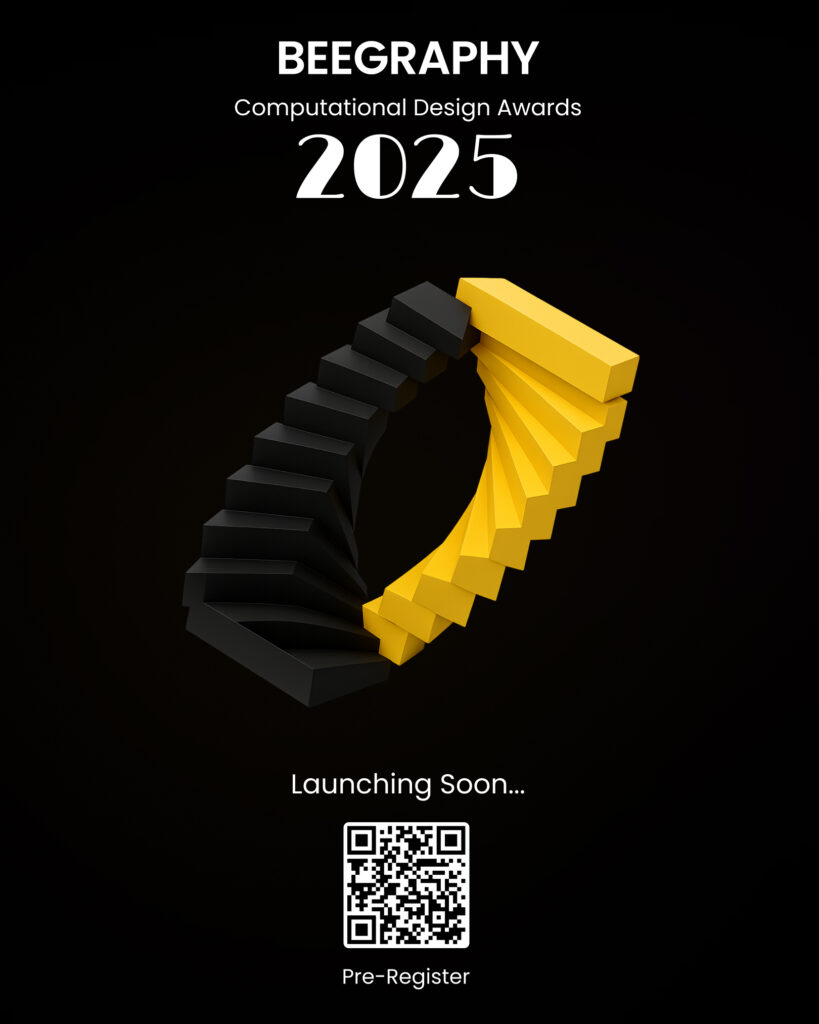
Pre-register now for BeeGraphy’s 2025 Computational Design Awards.
Pre-registration for BeeGraphy Computational Design Awards 2025 is now live. Click here to sign up


